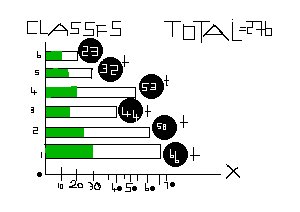Learning activities/School Census/lang-ko
환영합니다 | Portal | XO Korea | Deployment | Content | Hardware | Software | Mesh Network | Ethics | LOS | XO City | Accreditation | Consortium
아래는 나이지리아의 한 학급에서 진행된 과정입니다. 한국에서도 유사한 과정을 올려주세요. 이 페이지에 적기에 긴 분량은 새로운 페이지를 만들고 여기에 링크를 올려주세요.
Notes from Nigeria 5/07
"Wednesday was for Primary 6... [The teacher] chose to do math. The topic was graphs. He introduced the concept of ‘population’ to the children, asking them if they knew what it meant. We listened to different answers. Then he explained that the objective of the day was to know the population of Galadima School and how they could represent it with graphs. He went on to explain bar graphs. Afterwards, with my suggestion, we split into 5 teams, and each one had to go to a classroom and count the number of boys and the number of girls in it. My team had to go to Primary 5. The children asked the classroom teacher for permission to count the students because it was part of their class work. When we came back, [the teacher] explained with lots of details how to graph the Galadima School population. Children didn't wait until he explained the whole thing. They were already in Paint making the graph. They wanted to be accurate, so they tried and tried... and tried and tried... until one of them came up with a way to do it easier or faster. Then they shared the trick with the others... but then someone else came up with a way of doing it more accurately and passed it on to the others... Everybody was really into their work or helping others..." --Carla Gomez Monroy, Learning Consultant, OLPC
Task: Adapt This Story
Help adapt this story into a learning activity for children around the world.
What kinds of activities do we want? Read our educational activity guidelines to understand our vision for learning. Or, take a look at some sample learning activities to get a sense of what we're looking for.
Does this activity look good to you? Try it in your classroom and use the discussion page to tell us how it went. Or, use one of our activity templates to create a related activity and link to it below.
Activity: School Census
Count the number of students in your class; then, make a graph to display your results.
Created By
School Galadima, Primary 6 Teacher
Suggested Age Group
Grades 4-6
Subjects and Skills
Math: Counting, graphing, understanding data and statistics.
Arts: Understanding visual displays of information, creating graphs with Draw
Technology: Using Draw to make graphs.
Goals and Objectives
Understanding the concept of population.
Understanding the concept of bar graphs.
Practicing counting skills.
Teamwork.
Resources
Activity
- Introduce concept of population, using example of class as population.
- Explain how to represent population with a bar graph.
- Split into teams-- one team for each classroom in grade (or school)-- and send students to count the number of boys and girls in each class.
- In teams, use Draw to make a graph for each class.
- As a class, use Draw to make a graph for the grade (or school).
Extended Activities
Family Census
- At home, count the number of members of your family, noting girls and boys.
- Use Draw to make a graph of the number of girls and boys in your family.
- At school, report the number of members of your family, noting girls and boys.
- In teams, use Draw to make the following graphs: family size, number of children, number of girls, and number of boys.
- Share your team's graph with the class.
Pie Charts
- With the same data, explain how to represent population with pie charts.
- Split into teams-- use Draw to convert each bar graph to a pie chart.
- As a class, use Draw to make a pie chart for the grade (or school).
Related Activities
- Poll Builder: Lesson Plan Overview
- Bar Charts: http://cnx.org/content/m10217/latest/
- Survey Says: http://www.mamamedia.com/areas/grownups/new/learning/lessons/lesson_12.html
Commentary
Comments, feedback, links to other classes using this activity.


